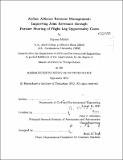Airline alliance revenue management : improving joint revenues through partner sharing of flight leg opportunity costs
Author(s)
Michel, Alyona
DownloadFull printable version (19.07Mb)
Alternative title
Improving joint revenues through partner sharing of flight leg opportunity costs
Other Contributors
Massachusetts Institute of Technology. Dept. of Civil and Environmental Engineering.
Advisor
Peter P. Belobaba.
Terms of use
Metadata
Show full item recordAbstract
Airlines participating in alliances offer code share itineraries (with flight segments operated by different partners) to expand the range of origin-destination combinations offered to passengers, thus increasing market share at little cost. The presence of code share flights presents a problem for airline revenue management (RM) systems, which aim to maximize revenues in an airline's network by determining which booking requests are accepted. Because partners do not jointly optimize revenues on code share flights, alliance revenue gains from implementing advanced RM methods may be lower than an individual airline's gains. This thesis examines seat availability control methods that alliance partners can adopt to improve the total revenues of the alliance without formally merging. Partners share information about the opportunity costs to their network, called "bid prices", of selling a seat on their own flight leg, a mechanism termed bid price sharing (BPS). Results show that BPS methods often improve revenues and work best for networks with certain characteristics and partners with similar RM systems that exchange recently calculated bid prices as often as possible. Gains are typically only achieved if both alliance partners participate in the code share availability decision (called dual control) rather than one partner only, but implementation of dual control is more difficult for airlines in practice. In the best case scenario, gains of up to .40% where achieved, which can translate into $120 million per year for the largest airlines. In our simulations, BPS with dual control and frequent bid price calculation and exchange was the only method that produced consistently positive revenue gains in all the scenarios tested. Therefore, alliance airlines must consider the trade off between revenue gains and implementation difficulties of more frequent bid price exchange or dual control.
Description
Thesis (S.M. in Transportation)--Massachusetts Institute of Technology, Dept. of Civil and Environmental Engineering, 2012. Cataloged from PDF version of thesis. Includes bibliographical references (p. 125-128).
Date issued
2012Department
Massachusetts Institute of Technology. Department of Civil and Environmental EngineeringPublisher
Massachusetts Institute of Technology
Keywords
Civil and Environmental Engineering.